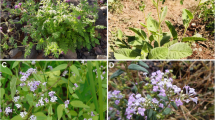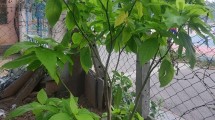Abstract
The objective of this study was to develop a herbal formulation to control dengue vector mosquitoes. PONNEEM, a novel herbal formulation prepared using the oils of neem (Azadirachta indica), karanj (Pongamia glabra) and their extracts, was tested for larvicidal, ovicidal and oviposition deterrent activities against Aedes aegypti and Aedes albopictus at 1, 0.5, 0.3 and 0.1 ppm concentrations. Cent percent larvicidal and ovicidal activities were observed at 0.1 ppm in the two mosquito species under laboratory and sunlight-exposed conditions up to 12 months from the date of manufacture. Oviposition deterrent activity of 69.97% and 71.05% was observed at 1 ppm concentration of PONNEEM against A. aegypti and A. albopictus, respectively. Reduction in enzyme levels for α-esterase was 0.089 ± 0.008 and 0.099 ± 0.140 μg napthol produced/min/mg larval protein; for β-esterase, it was 0.004 ± 0.009 and 0.001 ± 0.028 μg napthol produced/min/mg larval protein; for glutathione S-transferase, it was 10.4814 ± 0.23 and 11.4811 ± 0.21 μmol/min/mg larval protein and for total protein, it was 0.177 ± 0.010 and 0.008 ± 0.005 mg/individual larva in treated groups of A. aegypti and A. albopictus, respectively. The nontarget organisms such as Gambusia affinis and Diplonychus indicus were not affected. No mortality was observed in control. PONNEEM can be used effectively for the management of human vector mosquitoes.

Similar content being viewed by others
References
Abbot WS (1925) A method of computing the effectiveness of an insecticide. J Econ Entomol 18:265–267
Adebayo TA, Gbolade AA, Olaifa JI (1999) Comparative study of toxicity of essential oils to larvae of three mosquito species. Nigerian J Nat Prod Med 3:74–76
Ascher KRS (1993) Nonconventional insecticidal effects of pesticides available from the neem tree, Azadirachta indica. Arch Insect Biochem Physiol 22:433–449
Batabyal L, Sharma P, Mohan L, Maurya P, Srivastava CN (2009) Relative toxicity of neem fruit, bitter gourd, and castor seed extracts against the larvae of filaria vector, Culex quinquefasciatus (Say). Parasitol Res 105(5):1205–1210
Chaithong U, Choochote W, Kamsuk K, Jitpakdi A, Tippawangkosol P, Chaiyasit D, Champakaew D, Tuetun B, Pitasawat B (2006) Larvicidal effect of pepper plants on Aedes aegypti (L.) (Diptera: Culicidae). J Vector Ecol 31:138–144
Choochote W, Tuetun B, Kanjanapothi D, Rattanachanpichai E, Chaithong U, Chaiwong P, Jitpakdi A, Tippawangkosol P, Riyong D, Pitasawat B (2004) Potential of crude seed extract of celery, Apium graveolens L., against the mosquito Aedes aegypti (L.) (Diptera: Culicidae). J Vector Ecol 29:340–346
Corbet SA, Danahar CW, King V, Chalmers CL, Tiley CF (1995) Surfactant-enhanced essential oils as mosquito larvicides. Entomol Exp Appl 75:229–236
DeBach P, Rosen D (1991) Biological control by natural enemies, 2nd edn. Cambridge University Press, Cambridge
Deo PG, Hasan SB, Majumdar SK (1988) Toxicity and suitability of some insecticides for household use. Int Pest Control 30:118–129
Dondji B, Duchan S, Diabate A, Herve JP, Corbel V, Hougard JM, Santus R, Schrevel J (2005) Assessment of laboratory and field assays of sunlight induced killing of mosquito larvae by photo sensitizers. J Med Entomol 42:652–656
Figueiredo LTM, Fonseca BAL (1996) Dengue. In: Veronesi R, Focaccio R (eds) Tratado de Infectologia. Editora Atheneu, São Paulo, pp 201–214
Ganesh KN, Urmila J, Vijayan VA (2003) Pyrethroid susceptibility and enzyme activity in two malaria vectors, Anopheles stephensi (Liston) and Anopheles culicifacies (Giles) from Mysore, India. Indian J Med Res 117:30–38
Garcez WS, Garcez FR, da Silva LMGE, Hamerski L (2009) Larvicidal activity against Aedes aegypti of some plants native to the West-Central region of Brazil. Biores Technol 100:6647–6650
Gbolade AA, Oyedele AO, Sosan MB, Adewayin FB, Soyela OL (2000) Mosquito repellent activities of essential oils from two Nigerian Ocimum species. J Trop Med Plants 1:146–148
Ghani A (1998) Medicinal plants of Bangladesh. Asiatic Society of Bangladesh, Dhaka, p 270
Govindarajan M, Mathivanan T, Elumalai K, Krishnappa K, Anandan A (2011) Mosquito larvicidal, ovicidal, and repellent properties of botanical extracts against Anopheles stephensi, Aedes aegypti, and Culex quinquefasciatus (Diptera: Culicidae). Parasitol Res 109(2):353–367
Hafeez F, Akram W, Shaalan EA (2011) Mosquito larvicidal activity of citrus limonoids against Aedes albopictus. Parasitol Res 109(1):221–229
Halstead SB (2007) Dengue. Lancet 370:1644–1652
Hayes JB Jr, Laws ER Jr (1991) Handbook of pesticide toxicology, vol I. Academic Press, San Diego
Islam ME, Khatune NA, Wahed MII, Haque ME, Mosaddik MA (2003) Larvicidal activity of new glycoside, phenyl ethyl β-d glucopyranoside from the stem of the plant Sida rhombifolia. Pak J Biol Sci 6:73–77
Isman MB (2000) Plant essential oils for pest and disease management. Crop Prot 19:603–608
Kady GAE, Kamel NH, Mosleh YY, Bahght IM (2008) Comparative toxicity of two bio-insecticides (Spinotoram and Vertemic) compared with methomyl against Culex pipiens and Anopheles multicolor. World J Agri Sci 4:198–205
Kalaivani K, Senthil-Nathan S, Murugesan AG (2011). Biological activity of selected Lamiaceae and Zingiberaceae plant essential oils against the dengue vector Aedes aegypti L. (Diptera: Culicidae). Parasitol Res. doi:10.1007/s00436-011-2623-x
Kanis LA, Prophiro JS, da Silva Vieira E, do Nascimento MP, Zepon KM, Kulkamp-Guerreiro IC, da Silva OS (2011). Larvicidal activity of Copaifera sp. (Leguminosae) oleoresin microcapsules against Aedes aegypti (Diptera: Culicidae) larvae. Parasitol Res. doi:10.1007/s00436-011-2610-2
Kirtikar KR, Basu BD (1994) Indian medicinal plants, 2nd edn. Dehradun Publisher Ltd., India, pp 830–832
Locantoni L, Guisti F, Cristofaro M, Pasqualini L, Esposito F, Lupetti P, Habluetzel A (2006) Effect of neem extract on blood feeding oviposition and oocyte ultra structure in Anopheles stephensi Liston (Diptera: Culicidae). Tissue Cell 38:361–371
Lowry OH, Rosebrough NJ, Farr AL, Randall RJ (1951) Protein measurement with the Folin phenol reagent. J Biol Chem 193:265–275
Mohsen ZH, Jawad ALM, Al-Saadi M, Al-Naib A (1995) Anti-oviposition and insecticidal activity of Imperata cylindric (Gramineae). Med Vet Entomol 9:441–442
Mouches C, Magnin M, Berge JB, Silvestri M, Beyssatt V, Pasteur N, Georghiou GP (1987) Overproduction of detoxifying esterases in organophosphate resistant Culex mosquitoes and their presence in other insects. Proc Natl Acad Sci U S A 84(8):2113–2116
National Research Council (1992) Neem: a tree for solving global problems. Report of an Adhoc Panel of the Board on Science and Technology for International Development National Academy Press, Washington
Nicoletti M, Serafini M, Aliboni A, D'Andrea A, Mariani S (2010) Toxic effects of neem cake extracts on Aedes albopictus (Skuse) larvae. Parasitol Res 107(1):89–94
Nishimura H (2001) Aroma constituents in plants and their repellent activities against mosquitoes. Aroma Research 2:257–267
Parmar BS, Dutta S (1987) Evaluation of some oils as malathion synergists. Int J Trop Agric 5:223–226
Prophiro JS, da Silva MA, Kanis LA, da Rocha LC, Duque-Luna JE, da Silva OS (2011) First report on susceptibility of wild Aedes aegypti (Diptera: Culicidae) using Carapa guianensis (Meliaceae) and Copaifera sp. (Leguminosae). Parasitol Res (in press)
Rajkumar S, Jenanesan A (2002) Oviposition attractancy of Solunum aeriathum D. Don. leaf extract for Culex quinquefasciatus Say. J Exp Zoology India 5:221–224
Rajkumar S, Jebanesan A (2008) Bioactivity of flavonoid compounds from Poncirus trifoliata L. (Family: Rutaceae) against the dengue vector, Aedes aegypti L. (Diptera: Culicidae). Parasitol Res 104(1):19–25
Rao GR, Dhingra S (1997) Synergistic activity of some vegetable oils in mixed formulation with cypermethrin against instars of Spodoptera litura (Fabricius). J Entomol Res 21:153–160
Rozendaal JA (1997) Vector control Geneva. World Health Organization, Switzerland
Schmutterer H (1990) Properties of natural pesticides from the neem tree, Azadirachta indica. Ann Rev Entomol 35:271–297
Schmutterer H (2002) The neem tree (Azadirachta indica) and other Meliceous plants. In Source of unique natural products for integrated pest management, medicine, industry and other porposes, 1st edn. Neem Foundation, Mumbai
Shanmugasundaram R, Dutt MS, Arivazhagan A, Gayathri V, Jeyalakshmi T, Murthy PB (2001) Comparative study on the larvicidal property of various products against the larvae of Culex quinquefasciatus (Culicidae: Diptera). Pestology 25:33–35
Shanmugasundaram R, Jeyalakshmi T, Dutt MS, Murthy PB (2008) Larvicidal activity of neem and karanja oil cakes against mosquito vectors, Culex quinquefasciatus (Say), Aedes aegypti (L.) and Anopheles stephensi (L.). J Environ Biol 29(1):43–45
Sharma VP, Dhiman RC (1993) Neem oil as a sand fly (Diptera: Psychodidae) repellent. J Am Mosq Control Assoc 9:364–366
Sivagnaname N, Kalyanasundaram M (2004) Laboratory evaluation of methanolic extract of Atlantia monophylla (Family: Rutaceae) against immature stages of mosquitoes and non-target organisms. Mem Inst Oswaldo Cruz 99:115–118
Su T, Mulla MS (1998a) Antifeedancy of neem products containing Azadirachtin against Culex tarsalis and Culex quinquefasciatus (Diptera: Culicidae). J Vector Ecol 23:114–122
Su T, Mulla MS (1998b) Ovicidal activity of neem products (Azadirachtin) against Culex tarsalis and Culex quinquefasciatus (Diptera: Cilicidae). J Am Mosq Control Assoc 14:204–209
Templeton W (1969) An introduction to the chemistry of terpenoids and steroids. Butterworths, London
Tripathi AK, Prajapati V, Agarwal KK, Khanuja SPS, Kumar S (2000) Repellency and toxicity of oil from Artemisia annua to certain stored product beetles. J Econ Entomol 93:43–47
Tripathi AK, Prajapati V, Verma N, Bahl JR, Bansal RP, Khanuja SPS (2002) Bioactivities of the leaf essential oil of Curcuma longa (var. ch-66) on three species of stored-product beetles (Coleoptera). J Econ Entomol 95:183–189
Tsao R, Lee S, Rice PJ, Jensen C, Coats JR (1995) Monoterpenoids and their synthetic derivatives as leads for new insect control agents. In: Baker DR, Fenyes JG, Basarab GS (eds) Synthesis and chemistry of agrochemicals IV. American Chemical Society, Washington, pp 312–324
Warrier PK, Nambiar VPK, Ramankutty C (1995) Indian medicinal plants: a compendium of 500 species, vol 4. Universities Press, Mumbai, India
World Health Organization (WHO) website (2008a) Report on global surveillance of epidemic-prone infectious diseases. Dengue and dengue haemorrhagic fever (chapter 6). http://www.who.int/csr/resources/publications/surveillance/dengue.pdf. Accessed May 2008
World Health Organization (WHO) website (2008b) Dengue and dengue haemorrhagic fever. http://www.who.int/mediacentre/factsheets/fs117/en. Accessed Mar 2009
World Health Organization (1996) Report of the WHO informal consultation on the “Evaluation and testing of insecticides”. CTD/WHOPES/IC/96. pp. 1–69.
Zebitz CPW (1984) Effects of some crude and azadirachtin enrichd neem Azadirachta indica seed kernel extracts on larvae of Aedes aegypti. Entomol Exp Appl 35:11–16
Zebitz CPW (1986) Potential of neem seed kernel extracts in mosquito control. Proc. 3rd Int Neem Conf Nairobi, pp.555-573
Acknowledgement
The authors are thankful to the Entomology Research Institute, Loyola College for the financial support.
Author information
Authors and Affiliations
Corresponding author
Rights and permissions
About this article
Cite this article
Maheswaran, R., Ignacimuthu, S. A novel herbal formulation against dengue vector mosquitoes Aedes aegypti and Aedes albopictus . Parasitol Res 110, 1801–1813 (2012). https://doi.org/10.1007/s00436-011-2702-z
Received:
Accepted:
Published:
Issue Date:
DOI: https://doi.org/10.1007/s00436-011-2702-z




